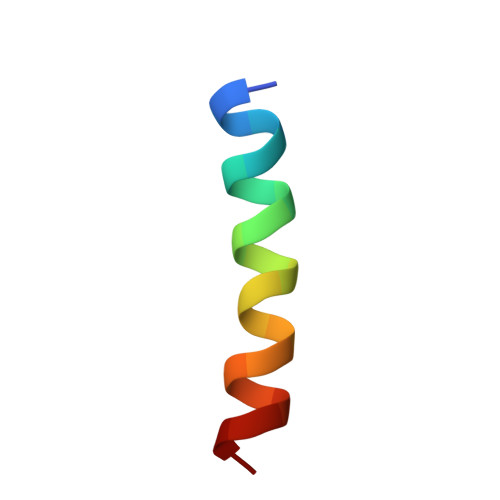Solution structure and cell selectivity of piscidin 1 and its analogues.
Lee, S.A., Kim, Y.K., Lim, S.S., Zhu, W.L., Ko, H., Shin, S.Y., Hahm, K.S., Kim, Y.(2007) Biochemistry 46: 3653-3663
- PubMed: 17328560
- DOI: https://doi.org/10.1021/bi062233u
- Primary Citation of Related Structures:
2OJM, 2OJN, 2OJO - PubMed Abstract:
Piscidin 1 (Pis-1) is a novel cytotoxic peptide with a cationic alpha-helical structure that was isolated from the mast cells of hybrid striped bass [Silphaduang, U., and Noga, E. J. (2001) Nature 414, 268-269]. Pis-1 is not selective for bacterial versus mammalian cells. In the present study, to develop novel antibiotic peptides with selectivity for bacterial cells, we examined the effect of substituting two glycine residues, Gly8 and Gly13, with Ala or Pro on this peptide's structure and biological activities. The bacterial cell selectivity of the peptides decreased in the following order: Gly-->Pro analogues > Gly-->Pro/Ala analogues > Pis-1 > Gly-->Ala analogues. The antimicrobial and hemolytic activities and abilities to permeabilize the model phospholipid membranes were higher for Pis-1 with Gly or Pro at position 8 than for its counterparts with either Gly or Pro at position 13. We determined the tertiary structure of Pis-1 and its analogues in the presence of SDS micelles by NMR spectroscopy. We found that Pis-1 has an alpha-helical structure from Phe2 to Thr21. Also, Pis-1 AA (Gly8, Gly13-->Ala8, Ala13) with higher antibacterial and hemolytic activity than Pis-1 has a stable alpha-helical structure from Phe2 to Thr21. Pis-1 PG (Gly-->Pro8) with bacterial cell selectivity has a hinge structure at Pro8, which provides flexibility in piscidin, followed by a three-turn helix from Val10 to Gly22 in the C-terminal region. Taken together, our results demonstrate that the conformational flexibility provided by introduction of a Pro at position 8, coupled with the primary anchoring of phenylalanines and histidines in the N-terminus to the cell membrane and the optimal length of the C-terminal amphipathic alpha-helix, are the critical factors that confer antibacterial activity and bacterial cell selectivity to Pis-1 PG. Pis-1 PG may be a good candidate for the development of a new drug with potent antibacterial activity but without cytotoxicity.
Organizational Affiliation:
Department of Bioscience and Biotechnology, Bio/Molecular Informatics Center, IBST, Konkuk University, Kwangjin-gu, Seoul 143-701, Korea.














